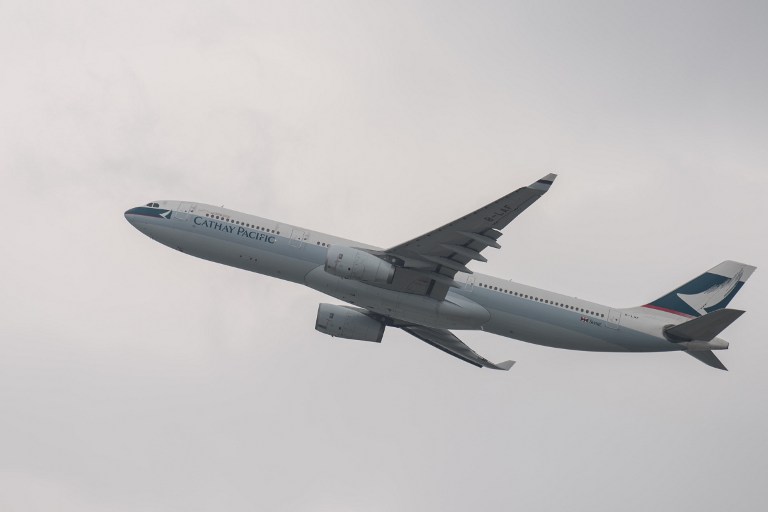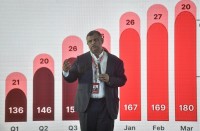
Hong Kong’s troubled flagship airline Cathay Pacific swung to a 74 million USD loss in 2016, the firm said March 15, citing “intense competition” from rival carriers. / AFP PHOTO / Anthony WALLACE
HONG KONG, China (AFP) — Hong Kong’s troubled flagship airline Cathay Pacific on Wednesday posted its first annual loss since the height of the financial crisis as it was hit by “intense competition” and a drop in demand from business travellers.
The firm is struggling despite an expansion of international air travel in the region as lower cost carriers, particularly from mainland China, eat into its market share.
Companies like China Eastern and China Southern Airlines are offering direct services to Europe and the United States from the mainland, while budget carriers like Spring Airlines offer regional routes, undermining Cathay’s once critical Hong Kong hub.
The airline is also losing premium travellers as it comes under pressure from Middle East rivals which are expanding into Asia and offering more luxury touches.
That has led to promotional prices for Cathay’s top tickets as they are sold to leisure travellers.
Analysts said other established Asian operators were similarly suffering from increased competition, but believed Cathay’s major fuel-hedging losses put it in an even weaker position.
Its $74 million net loss in 2016 reversed a $773 million profit in the previous year and comes as the firm prepares a wholesale review of its operations, with chairman John Slosar warning 2017 would be similarly “challenging”.
The results, the worst since 2008, were also well off expectations, with an average profit of $57.9 million forecast by analysts in a Bloomberg News survey.
The company’s shares dropped as much as five percent in early afternoon trade before finishing 1.4 percent down.
– ‘Leaner organisation’ –
Cathay announced a major restructuring programme in January that will see jobs axed, but it has not said how many.
“Our organisation will become leaner,” Slosar said in a statement to the Hong Kong exchange on Wednesday. “Our aim is to reduce our unit costs excluding fuel over the next three years.”
Passenger revenue dropped 8.4 percent year-on-year to $8.6 billion, hit by overcapacity in the market and weak foreign currencies.
Analyst Jackson Wong of Huarong International Securities said Cathay had lost its niche and would find it hard to turn the corner.
“For a big company like this, with competition in the market now, it’s extremely difficult to turn around the business,” he told AFP.
Wong said cost-cutting was the path back to profitability but believed the firm needed to be clearer about what its restructuring would entail to win back investor confidence.
Other observers said Cathay was not offering a quality experience that justified its prices.
“As a passenger of Cathay Pacific when I travel business class it’s OK, but if I travel economy class, I feel like I’m sitting in a budget airline cabin. This is a big problem,” said Dickie Wong of Kingston Securities.
He added the management had done a “disastrous job” over fuel hedging.
Cathay said it had benefited from low oil prices — fuel accounts for a huge portion of a carrier’s costs — but that advantage was reduced by $1.1 billion in hedging losses.
Those losses were “largely incurred on hedges put in place when the fuel price was much higher than today” Slosar said.
Oil hedging is when an airline locks in prices of fuel at a pre-determined level for a certain amount of time.
However, analyst William Horton told Bloomberg News that Cathay would “ride out” the crisis and stay committed to its premium strategy in Hong Kong as the city’s airport plans a third runway.
International travel in the Asia-Pacific grew 8.3 percent in 2016, according to the International Air Transport Association.
It beat global growth figures of 6.3 percent and was only behind the Middle East in the regional rankings.
But high-profile carriers have nonetheless felt the pinch.
Singapore Airlines saw net profit drop 35.6 percent in the final three months of 2016 while Japan Airlines reported a 24.6 percent fall in April-December.
© Agence France-Presse







